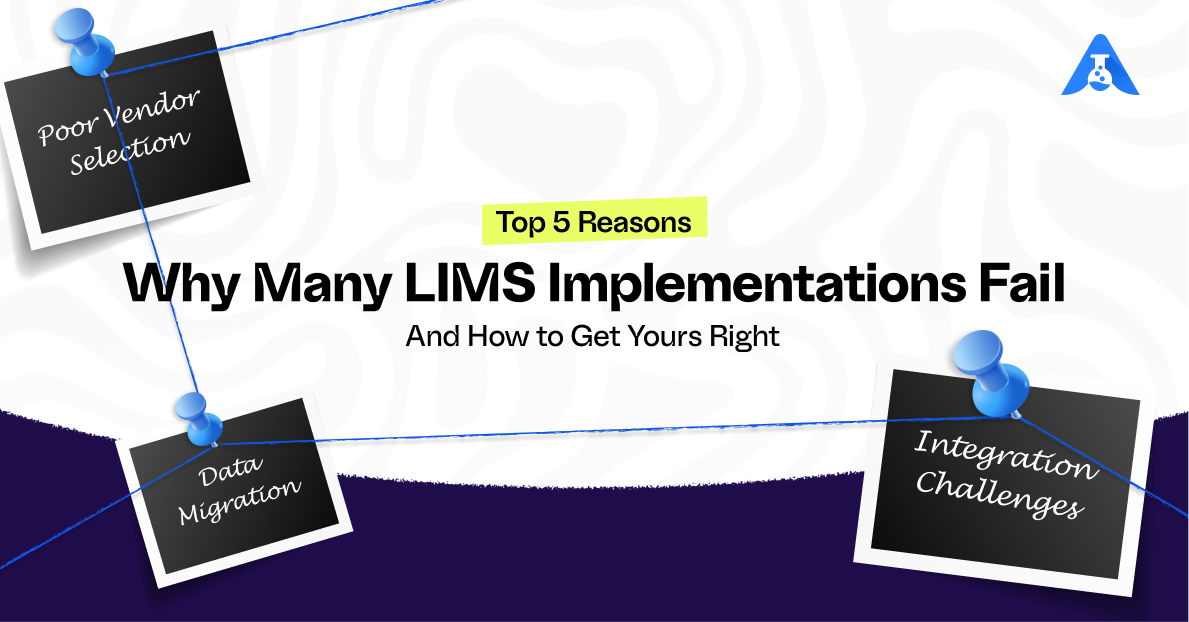CSols Inc. is recognized as the premier lab informatics solutions provider in North America. We have earned and maintained a reputation for excellence in everything we do for more than 25 years. Our team of informatics, domain, regulatory, data, and IT experts has evolved beyond the lab to provide informatics expertise to forward-thinking organizations in life sciences and other industries. As a truly independent firm, we provide objective guidance and tailored solutions through our holistic services of developing informatics and data strategies and implementing, integrating, enhancing, and validating informatics systems.
The goals of LIMS implementation are to streamline operations, enhance data integrity, and improve efficiency. But these goals won’t happen if the implementation can’t deliver your team’s expectations or, even worse, it fails. The good news is that most LIMS implementation failures are preventable if you know what to watch out for and take the right approach.
Why LIMS Implementations Often Go Wrong
Understanding the pitfalls in any project is the first step to avoiding them. This blog post looks at five reasons why LIMS implementations go off track and how to address them to see an implementation through to success.
1. Incomplete Requirements and Uncontrolled Scope
Requirements gathering and the associated scope definition is by far the biggest barrier to LIMS implementation success, which can lead to many of the other challenges on this list. In any LIMS implementation, the vendor knows the product but doesn’t know your lab’s processes. Your lab staff know what they want the LIMS to do but may not know what they need or how the LIMS can best be configured to meet those needs. Throw in your organization’s IT team who have never seen the inside of a LIMS before, and you’ve got a perfect storm of miscommunication.
There are direct consequences of inadequate requirements definition, too:
- scope creep —new requirements are continually added during implementation to meet previously unrecognized needs
- improper or overlooked prioritization of essential functionalities
2. Inadequate Planning and Project Management
The next most important pitfall in LIMS implementation is project management. A LIMS project manager should have a specific blend of skills honed through experience, skills that are necessary to deliver a successful implementation. A LIMS has defined workflows and processes that can be configured to some extent to meet lab workflows. If your workflows cannot be changed to meet the LIMS at least halfway, you may need extensive customization.
Any LIMS customization adds time, expense, and potential validation burdens. In the absence of a detailed plan with defined timelines and milestones, you can quickly find yourself falling behind and under resourced.
3. Insufficient User Engagement and Buy-in
Another project killer is failure to get the end users on board with the new LIMS implementation. This often starts with excluding them from the requirements gathering process (see Reason 1). If you cannot communicate the value of the new system to its users, you will run into resistance to change.
The most common mistake in this area is ignoring user training and change management, which are both important even if your users are looking forward to the new system. The users must embrace the system, or it will not succeed.
4. Data Migration, Technical, and Integration Challenges
This group of challenges also can arise because of Reason 1. Without a robust requirements gathering process, your organization may underestimate the complexity and volume of data to be migrated. Concurrently, you may find issues with data quality, cleanliness, and consistency and you may not have a plan for data validation post-migration. These are all critical parts of successful LIMS implementations.
Additional technical and integration challenges such as the following may also arise:
- Problems with software compatibility and integration with existing instruments or systems
- Unexpected technical hurdles or platform limitations
- Lack of expertise in configuring or customizing the LIMS effectively
5. Vendor Misalignment or Poor Vendor Selection
Finally, you may have been swayed by a slick vendor demonstration and ended up with a product based solely on price or features, not cultural fit or support. The product may be incapable of meshing with your lab’s workflows without extensive customization. This misalignment can lead to unclear communication and unmet expectations between you and the vendor. You may not receive adequate vendor support after the implementation.
How to Get Your LIMS Implementation Right
So, what can you do to ensure your LIMS implementation goes right the first time? LIMS professionals know that success isn’t about avoiding challenges; it’s built by having a proactive strategy to address them. Here’s how to set your LIMS project up for success:
- Define Clear, Detailed Requirements and Scope—Conduct thorough business process analysis and user interviews; prioritize “must-have” vs. “nice-to-have” features; and establish clear scope boundaries and a formal change request process.
- Plan Meticulously and Manage the Project Actively—Build a detailed project plan with realistic timelines, budgets, and resource allocation; appoint a core project team with appropriate bandwidth; choose a suitable project management methodology.
- Drive User Engagement, Manage Change, and Foster Buy-in—involve key end-users from the outset and get them onboard with the benefits to them and the organization (your LIMS champions); develop a multifaceted, ongoing training program and accessible resources for users; celebrate quick wins and demonstrate the value of the new system.
- Develop a Robust Data Migration Strategy and Plan for Technical Integration Early—Don’t neglect data cleansing and validation; identify and resolve issues early; prioritize critical data for migration and consider archiving historical data; conduct thorough technical assessments of existing infrastructure and instruments; plan for necessary integrations well in advance.
- Choose the Right Vendors and Collaborate Closely—Check client references, assess vendor support, and understand the implementation methodology; establish clear communication channels and documentation processes; select an implementation partner based on their expertise, track record, and cultural fit (not just price).
The Role of Expert Consultants: Your Partner in LIMS Implementation Success
If your organization is unfamiliar with any of the necessary elements for LIMS implementation success, external expertise is an excellent choice to bridge internal skill gaps. Most laboratory staff members will only experience one or two full LIMS implementations in a career. Expert LIMS consultants do this work several times a year.
LIMS consultants such as those at CSols are well-versed in requirements gathering, project leadership, change management, data migration, and partnering with vendors. CSols has a strong track record of successful implementations with a vendor-agnostic approach, leading to a 97% customer satisfaction rating.
Conclusion
A LIMS implementation doesn’t have to be a source of frustration or lost revenue. By understanding the common pitfalls and proactively applying the right strategies, you can transform a challenging project into a powerful asset for your laboratory. Don’t leave the success of your LIMS to chance. Partner with experienced professionals who can guide you through every step.




